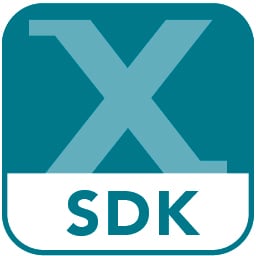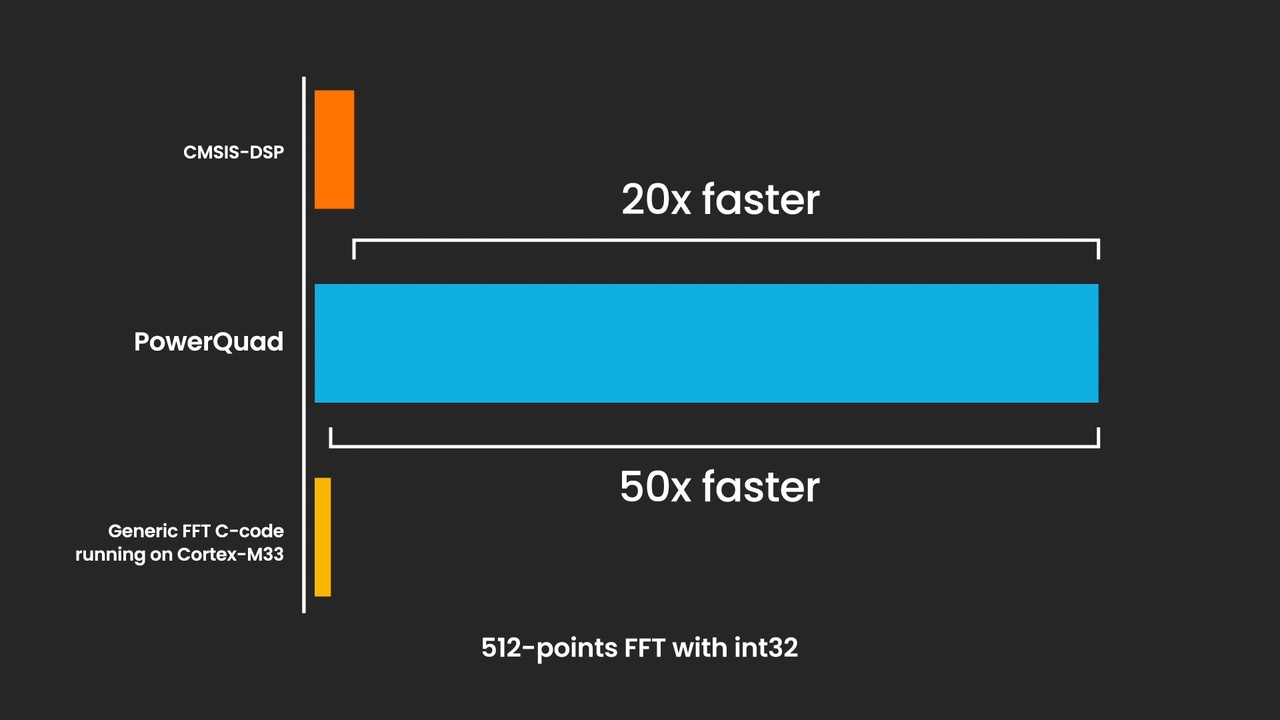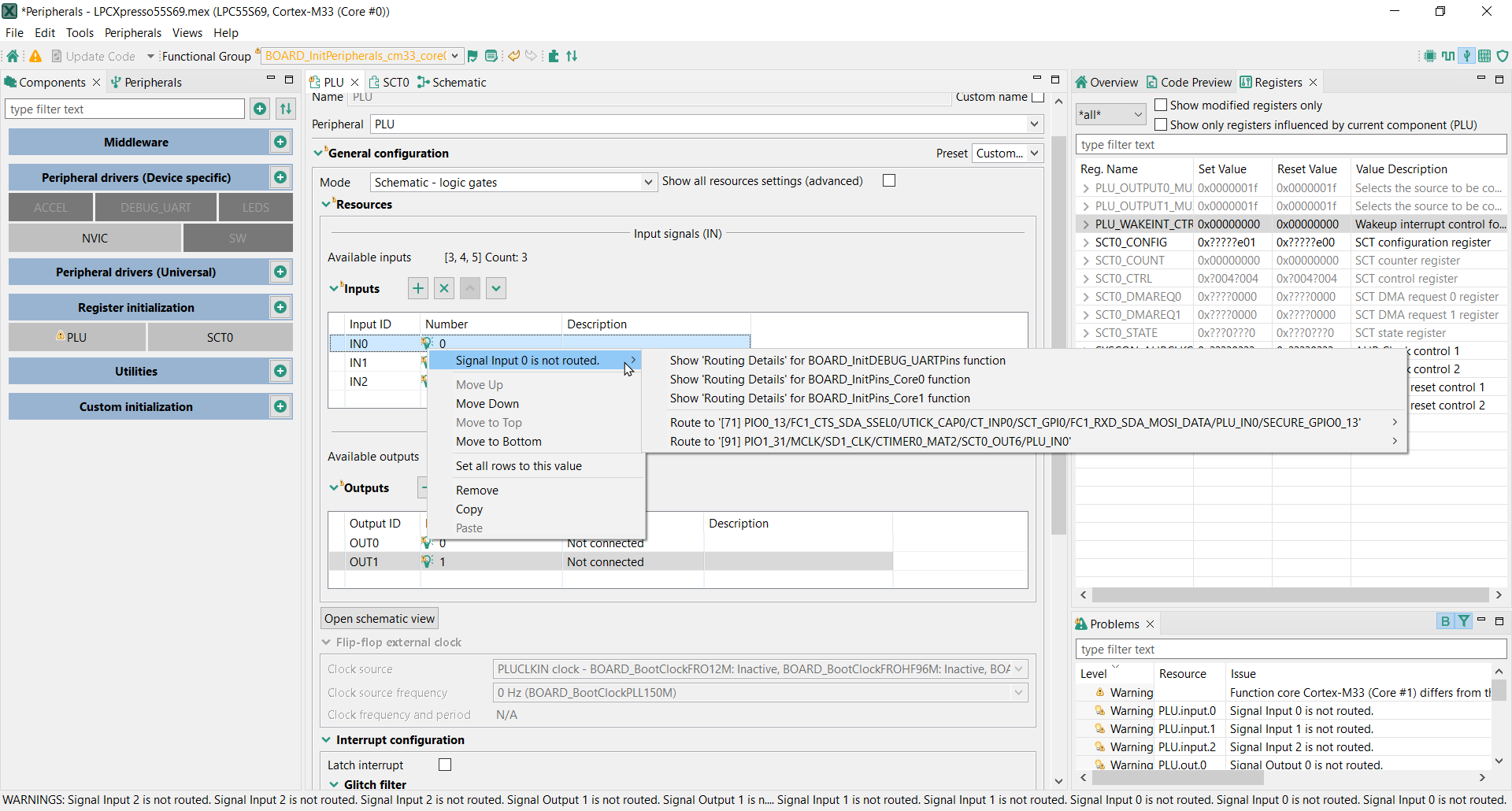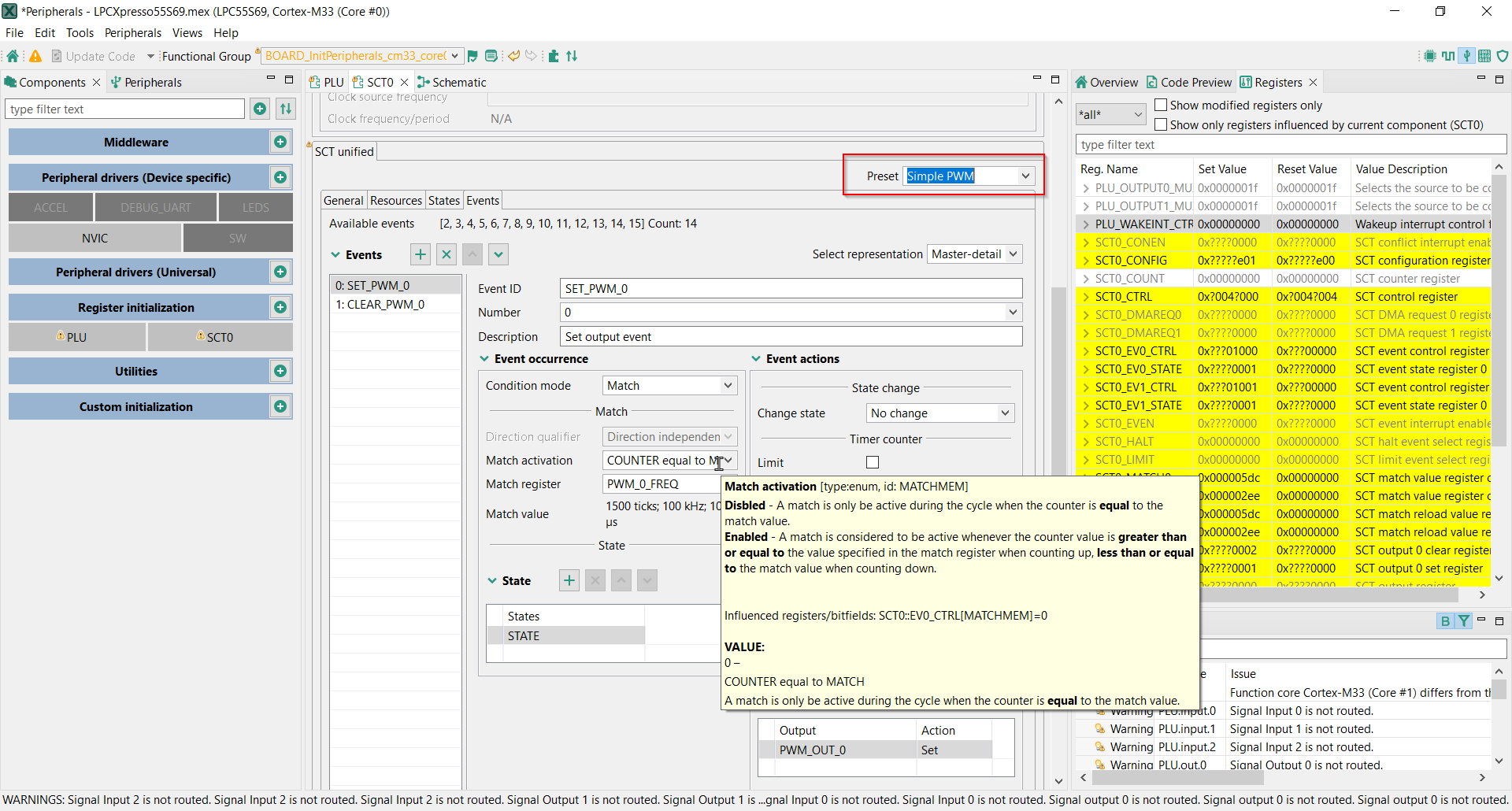Programmable Logic
The LPC804 MCU and several devices in the LPC5500 and MCX N series incorporate a
Programmable Logic unit (PLU) that can be used to implement a variety of
interfaces and/or glue logic functions, reducing system component count
and often greatly reducing processing load on the MCU itself. Logic
designs for the
PLU
can be created and validated using the PLU Register Initialization
Component in the peripherals tool from the MCUXpresso configuration tools
suite.
Devices with the PLU feature are shown below. Note that the SDK support
for these boards can also be downloaded from within MCUXpresso IDE.
Coprocessors
Arm Cortex-M33 Coprocessor
The Armv8-M architecture includes support for coprocessor extensions, and
NXP has used this capability to develop highly efficient extensions for
DSP and security-related processing.
PowerQuad Coprocessor
PowerQuad is a coprocessor designed by NXP to improve energy efficiency
and performance when implementing DSP algorithms using its MCUs based on
Cortex-M33 core. PowerQuad can be programmed directly or via an API that
is compatible with Arm’s CMSIS-DSP library. MCUXpresso SDK includes API
header files to support CMSIS-DSP, plus several examples showing their
use.
Supported CMSIS-DSP API calls include:
-
Matrix functions
- arm_mat_add_q15, arm_mat_add_q31, arm_mat_add_f32
- arm_mat_sub_q15, arm_mat_sub_q31, arm_mat_sub_f32
- arm_mat_mult_q15, arm_mat_mult_q31, arm_mat_mult_f32
- arm_mat_inverse_f32
- arm_mat_trans_q15, arm_mat_trans_q31, arm_mat_trans_f32
- arm_mat_scale_q15, arm_mat_scale_q31, arm_mat_scale_f32
-
Math functions
- arm_sqrt_q15, arm_sqrt_q31
- arm_sin_q15, arm_sin_q31, arm_sin_f32
- arm_cos_q15, arm_cos_q31, arm_cos_f32
-
Filter functions
- arm_fir_q15, arm_fir_q31, arm_fir_f32
- arm_conv_q15, arm_conv_q31, arm_conv_f32
- arm_correlate_q15, arm_correlate_q31, arm_correlate_f32
-
Transform functions
- arm_rfft_q15, arm_rfft_q31
- arm_cfft_q15, arm_cfft_q31
- arm_ifft_q15, arm_ifft_q31
- arm_dct4_q15, arm_dct4_q31
PowerQuad has other hardware capabilities, such as transcendental
functions, and examples of using these are also provided in the SDK.
Devices with PowerQuad are shown below. Note that the SDK support for
these boards can also be downloaded from within MCUXpresso IDE.
|
| Device Family |
Cores |
Recommended Evaluation Boards
|
| LPC55S6x |
Dual Cortex-M33 |
LPCXpresso55S69
|
| i.MX RT685 |
Cortex-M33 and Cadence® Tensilica® HiFi 4 DSP
|
MIMXRT685-EVK
|
CASPER
To address the challenges of asymmetric cryptography, NXP has developed
CASPER, a Cryptographic Accelerator and Signaling Processing Engine with
RAM-sharing. It is a hardware accelerator engine for certain asymmetric
cryptographic algorithms, such as Elliptic Curve Cryptography (ECC).
CASPER sits on the Cortex-M33 coprocessor buses. CASPER is utilized by
NXP’s implementation of MbedTLS in MCUXpresso SDK, so you can take
advantage of the speed and energy-saving benefits with no additional
effort compared to a software-only approach.
Devices with CASPER are shown below. Note that the SDK support for these
boards can also be downloaded from within MCUXpresso IDE.
|
| Device Family |
Cores |
Recommended Evaluation Boards
|
| LPC55S6x |
Dual Cortex-M33 |
LPCXpresso55S69
|
| i.MX RT685 |
Cortex-M33 and Cadence Tensilica HiFi 4 DSP |
MIMXRT685-EVK
|
Specialized Interfaces
NXP microcontrollers include powerful, innovative interface peripherals to
reduce system cost, improve energy consumption and leave more processor
cycles for your application.
Interface Block
LPC5500 series MCUs incorporate a specialized, programmable peripheral
block that can be used to implement a variety of interfaces with little or
zero overhead for the Arm cores they contain, enabling you to implement
lower system cost implementations, save energy and leave more processing
cycles for your applications. NXP provides drivers and examples for some
specialized peripherals (upon request) that can be used with MCUXpresso
SDK projects.
Devices with this specialized peripheral block feature are shown below.
State-controlled Timers
Several MCUs in NXP’s portfolio include powerful peripherals that can
solve many logic and timing challenges.
The State Configurable Timer (SCT) is available on most LPC and i.MX RT600
microcontrollers. At its core, the SCT is a up/down counter that can be
sequenced with up to 16 events on LPC5500 series devices (the number of
events supported varies with the device family). The events can be
triggered by IO or by one of 16 possible counter matches. An event can
then update a state variable, generate IO activity (set, clear, toggle) or
start/stop/reverse the counter. In some cases, the SCT can be used to
build a semiautonomous subsystem, with very low MCU overhead to manage it.
Using these capabilities, a broad range of sophisticated system designs
can be implemented, often achieving system cost savings by reducing the
need for external FPGAs or other components. MCUXpresso SDK includes
examples of PWM timer implementations using the SCT, and the MCUXpresso
Peripheral Configuration Tool enables design of state machine-controlled
timers on-the-fly.
FlexIO Module
The FlexIO module is available in several members of the K32, Kinetis,
i.MX RT MCU families. The FlexIO module is very flexible, allowing you to
configure it according to your communication needs; it is capable of
emulating various serial communication protocols such as UART, SPI and
I²C. The main components of the FlexIO module are the shifters,
timers and pins; data is loaded onto a shifter and a timer is assigned to
generate the shifter clock and use a pin to input/output the data to/from
the shifter. Shifters have a timer assigned to them to generate the shift
clock and it can be configured to shift data in or out. Beyond serial
interfaces, FlexIO can also emulate parallel interfaces, such as LCD
display drivers, with very low MCU overheard. Examples using FlexIO to
emulate I²C, I²S, UART, SPI and displays that match
the 8080 and 6800 bus protocols are included in MCUXpresso SDK and
Peripheral configuration tools, along with PWM driver examples. Examples
for camera interfaces and IrDA camera interfaces are available in
application notes from the NXP website by searching for “FlexIO
application note”.
The table below shows which devices include the SCT and/or FlexIO special
peripherals.
|
| Device Family |
Cores |
FlexIO |
SCT |
| K8x, K27/28 |
Cortex-M4 |
|
- |
| KE1xx |
Cortex-M4/M0+ / Cortex-M0+ |
|
- |
| KL (excl. KL0x) |
Cortex-M0+ |
|
- |
| K32 L |
Cortex-M4/M0+ / Cortex-M0+ |
|
- |
| i.MX RT1010 |
Cortex-M7 |
|
- |
| i.MX RT1020 |
Cortex-M7 |
|
- |
| i.MX RT1050 |
Cortex-M7 |
|
- |
| i.MX RT1060 |
Cortex-M7 |
|
- |
| i.MX RT1160 |
Cortex-M7 / Cortex-M4 |
|
- |
| i.MX RT1170 |
Cortex-M7 / Cortex-M4 |
|
- |
| LPC81x/82x/83/x84x |
Cortex-M0 / M0+ |
- |
|
| LPC51U68 |
Cortex-M0+ |
- |
|
| LPC54000 |
Cortex-M4 |
- |
|
| LPC5500 |
Cortex-M33 / Dual Cortex-M33 |
- |
|
| i.MX RT500 |
Cortex-M33 / Cadence Tensilica Fusion F1 DSP |
|
|
| i.MX RT600 |
Cortex-M33 / Cadence Tensilica HiFi 4 DSP |
- |
|
| MCX N23x |
Cortex-M33 |
|
- |
| MCX N94x/54x |
Cortex-M33 |
|
|
| MCX W71x |
Cortex-M33 |
|
|
| MCX W72x |
Cortex-M33 |
|
|
FlexPWM Module
The Flex Pulse Width Modulator (FlexPWM) module is an advanced component designed for precise motor control. It features multiple PWM submodules used for driving multi-phase motors. The FlexPWM module can generate a variety of switching patterns, including highly sophisticated waveforms, making it ideal for detailed motor control applications. This functionality ensures efficient and smooth operation in complex motor-driven systems, providing the necessary control and precision required for optimal performance.
For more information on motor control applications leveraging (not only) FlexPWM please visit Motor Control SDK page.













